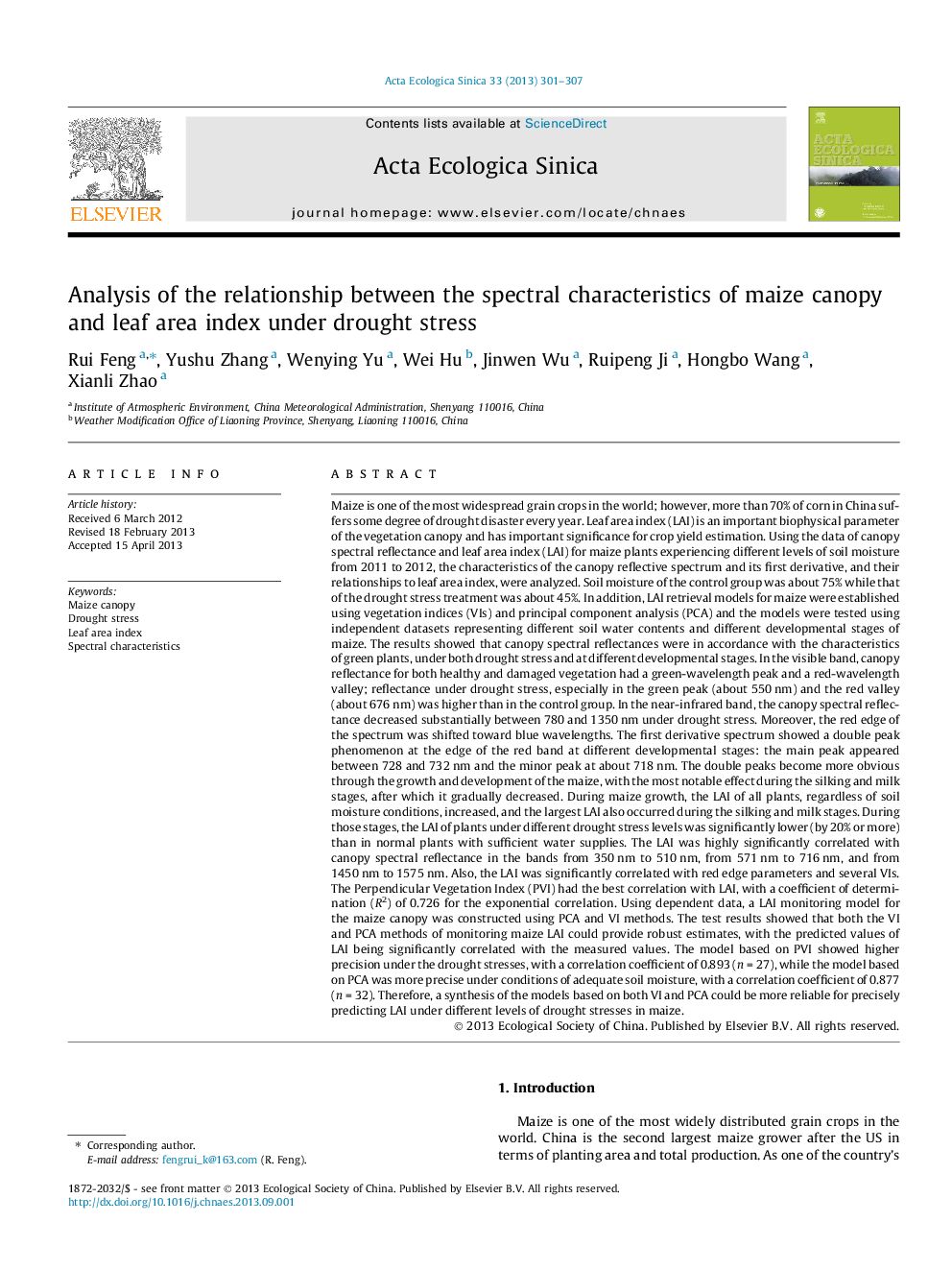| کد مقاله | کد نشریه | سال انتشار | مقاله انگلیسی | نسخه تمام متن |
|---|---|---|---|---|
| 4379836 | 1303943 | 2013 | 7 صفحه PDF | دانلود رایگان |
عنوان انگلیسی مقاله ISI
Analysis of the relationship between the spectral characteristics of maize canopy and leaf area index under drought stress
دانلود مقاله + سفارش ترجمه
دانلود مقاله ISI انگلیسی
رایگان برای ایرانیان
کلمات کلیدی
موضوعات مرتبط
علوم زیستی و بیوفناوری
علوم کشاورزی و بیولوژیک
بوم شناسی، تکامل، رفتار و سامانه شناسی
پیش نمایش صفحه اول مقاله

چکیده انگلیسی
Maize is one of the most widespread grain crops in the world; however, more than 70% of corn in China suffers some degree of drought disaster every year. Leaf area index (LAI) is an important biophysical parameter of the vegetation canopy and has important significance for crop yield estimation. Using the data of canopy spectral reflectance and leaf area index (LAI) for maize plants experiencing different levels of soil moisture from 2011 to 2012, the characteristics of the canopy reflective spectrum and its first derivative, and their relationships to leaf area index, were analyzed. Soil moisture of the control group was about 75% while that of the drought stress treatment was about 45%. In addition, LAI retrieval models for maize were established using vegetation indices (VIs) and principal component analysis (PCA) and the models were tested using independent datasets representing different soil water contents and different developmental stages of maize. The results showed that canopy spectral reflectances were in accordance with the characteristics of green plants, under both drought stress and at different developmental stages. In the visible band, canopy reflectance for both healthy and damaged vegetation had a green-wavelength peak and a red-wavelength valley; reflectance under drought stress, especially in the green peak (about 550 nm) and the red valley (about 676 nm) was higher than in the control group. In the near-infrared band, the canopy spectral reflectance decreased substantially between 780 and 1350 nm under drought stress. Moreover, the red edge of the spectrum was shifted toward blue wavelengths. The first derivative spectrum showed a double peak phenomenon at the edge of the red band at different developmental stages: the main peak appeared between 728 and 732 nm and the minor peak at about 718 nm. The double peaks become more obvious through the growth and development of the maize, with the most notable effect during the silking and milk stages, after which it gradually decreased. During maize growth, the LAI of all plants, regardless of soil moisture conditions, increased, and the largest LAI also occurred during the silking and milk stages. During those stages, the LAI of plants under different drought stress levels was significantly lower (by 20% or more) than in normal plants with sufficient water supplies. The LAI was highly significantly correlated with canopy spectral reflectance in the bands from 350 nm to 510 nm, from 571 nm to 716 nm, and from 1450 nm to 1575 nm. Also, the LAI was significantly correlated with red edge parameters and several VIs. The Perpendicular Vegetation Index (PVI) had the best correlation with LAI, with a coefficient of determination (R2) of 0.726 for the exponential correlation. Using dependent data, a LAI monitoring model for the maize canopy was constructed using PCA and VI methods. The test results showed that both the VI and PCA methods of monitoring maize LAI could provide robust estimates, with the predicted values of LAI being significantly correlated with the measured values. The model based on PVI showed higher precision under the drought stresses, with a correlation coefficient of 0.893 (n = 27), while the model based on PCA was more precise under conditions of adequate soil moisture, with a correlation coefficient of 0.877 (n = 32). Therefore, a synthesis of the models based on both VI and PCA could be more reliable for precisely predicting LAI under different levels of drought stresses in maize.
ناشر
Database: Elsevier - ScienceDirect (ساینس دایرکت)
Journal: Acta Ecologica Sinica - Volume 33, Issue 6, December 2013, Pages 301-307
Journal: Acta Ecologica Sinica - Volume 33, Issue 6, December 2013, Pages 301-307
نویسندگان
Rui Feng, Yushu Zhang, Wenying Yu, Wei Hu, Jinwen Wu, Ruipeng Ji, Hongbo Wang, Xianli Zhao,